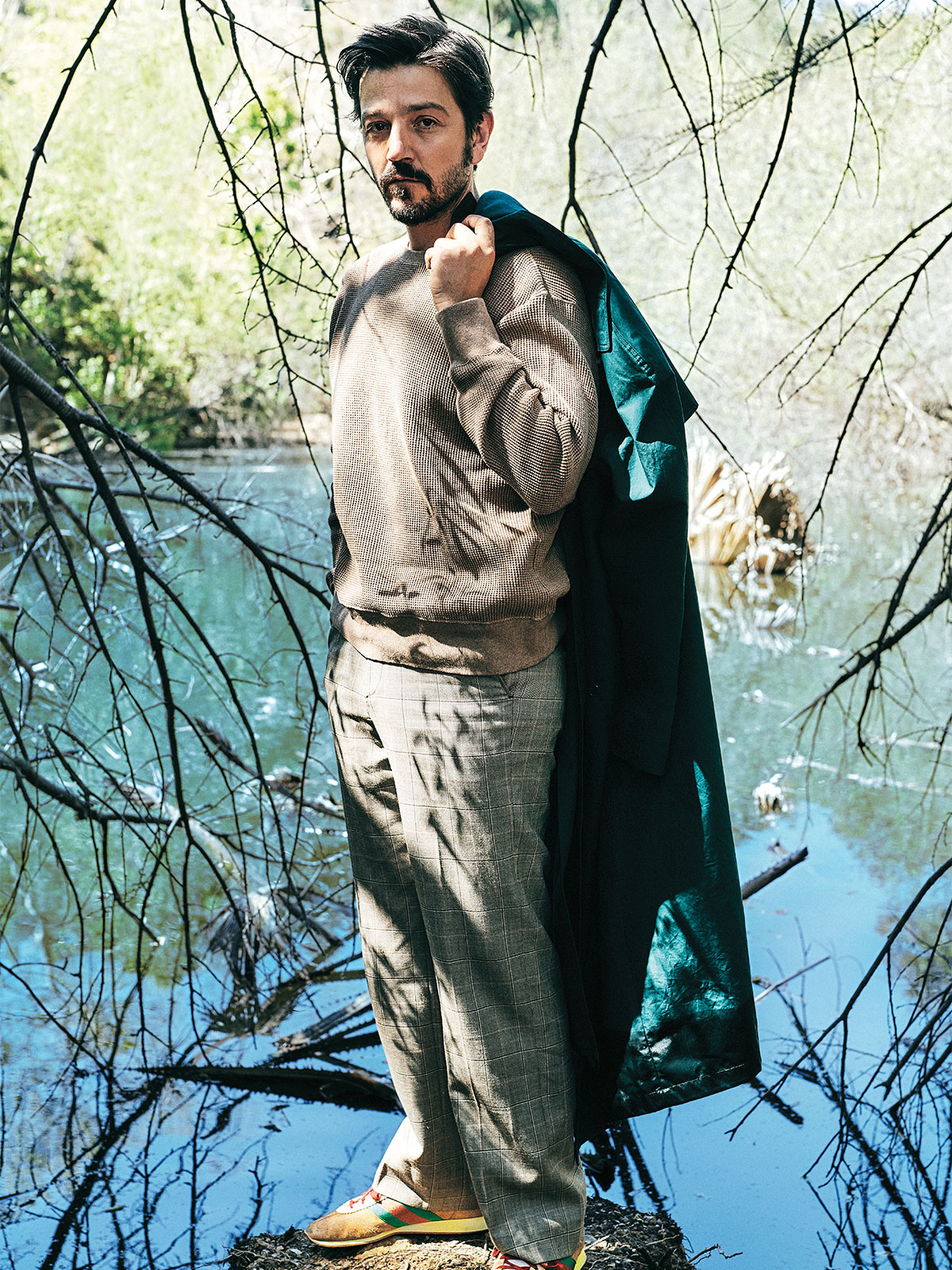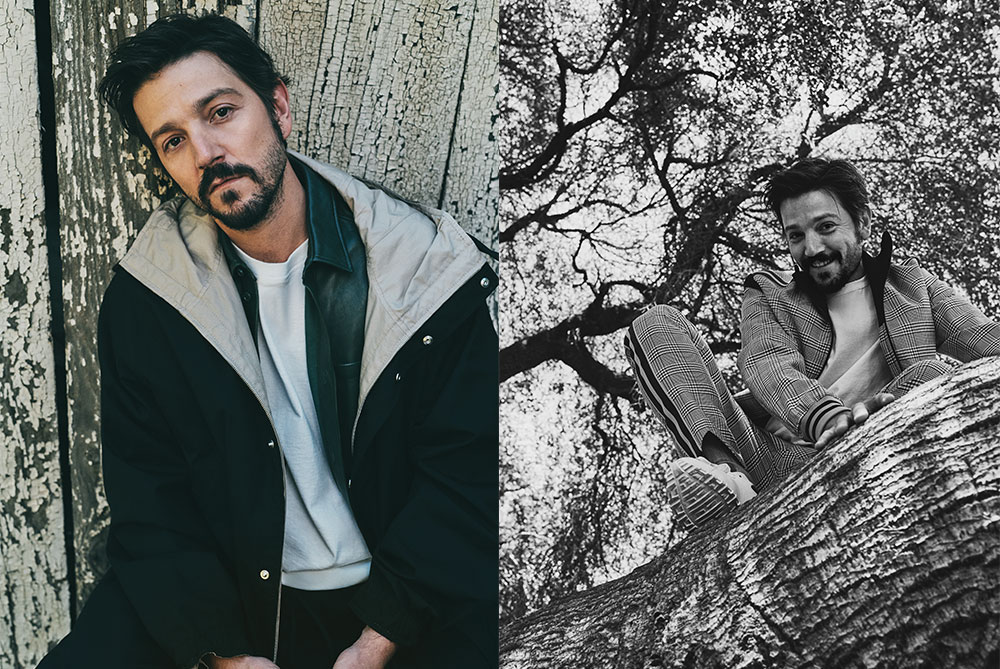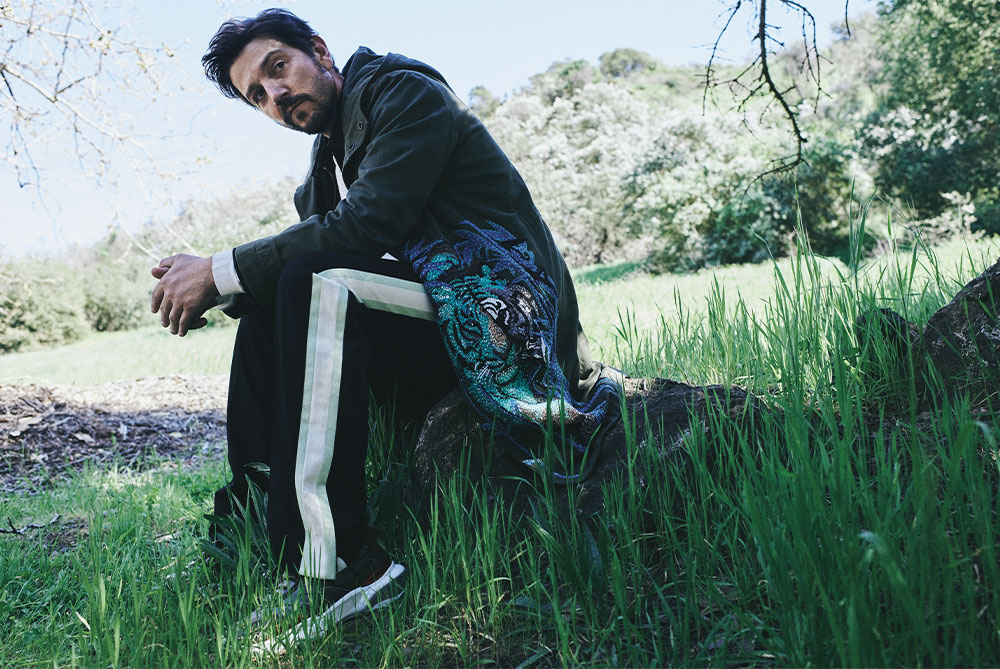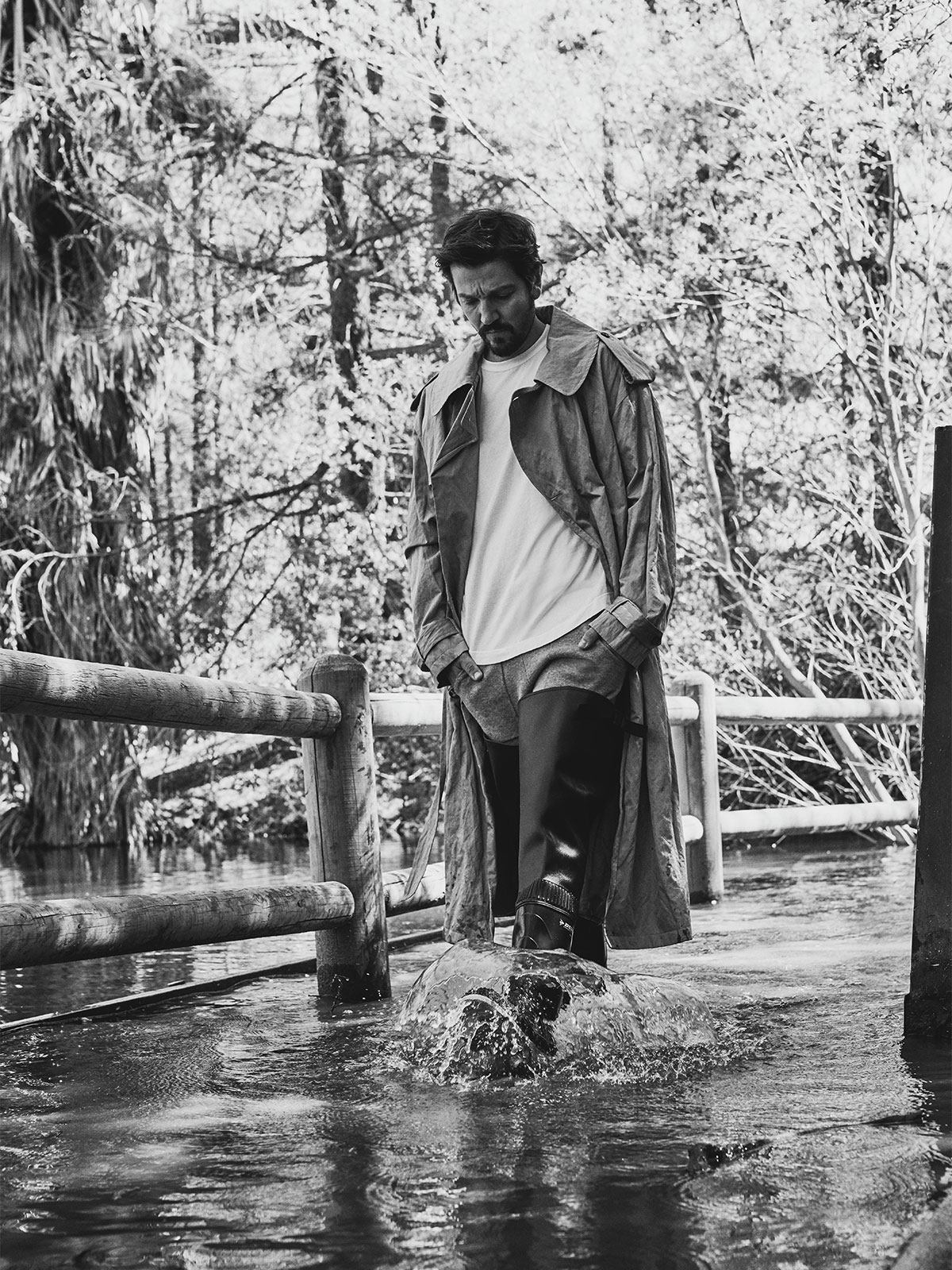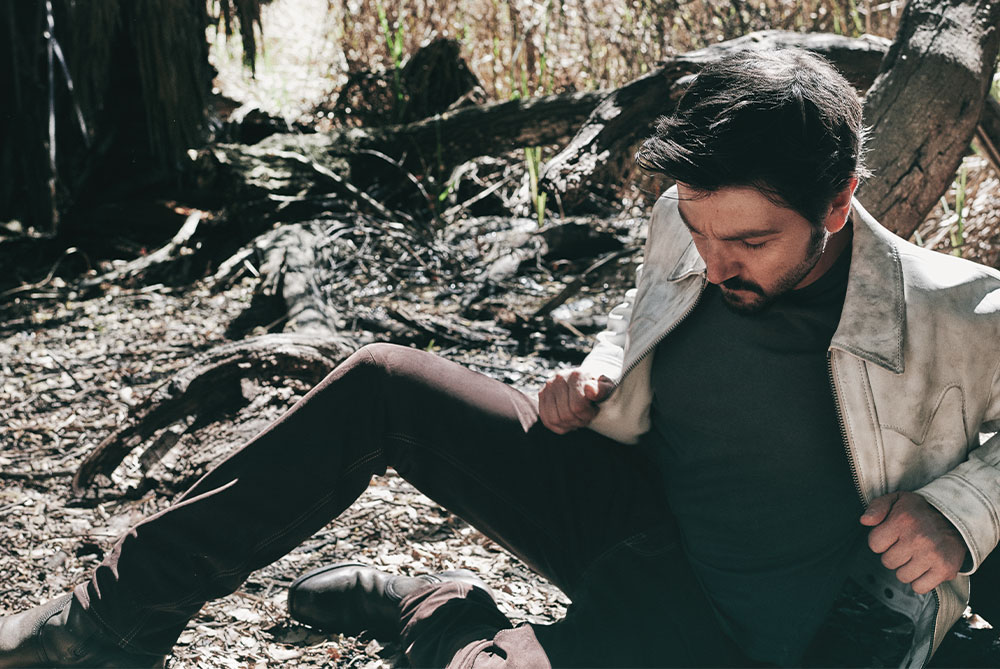Diego Luna talks love-hating L.A., fatherhood and the state of Mexican filmmaking
Words by HELENA DE BERTODANO
Photography by BEAU GREALY
Creative & Fashion Direction by ALISON EDMOND
Diego Luna is working against the clock to find a pink violin. It makes his day job — controlling the Mexican drug trade as kingpin Félix Gallardo in Narcos: Mexico — look like a doddle. “My task is to buy a pink violin for my daughter before I fly home tomorrow morning,” he explains, sounding far more stressed than the smooth-talking Gallardo. How about buying a normal violin and having it painted? “I don’t think that will work,” he replies forlornly. “There must be somewhere on Sunset Boulevard that sells pink violins …”
In many ways, it’s hard to imagine Luna, who is boyishly good-looking, a devoted father and one of the most internationally recognized Mexicans, as a bad guy. But it is a tribute to his powers as an actor that in Narcos: Mexico he is terrifyingly convincing as El Padrino (The Godfather), the man behind modern Mexican drug trafficking. In the last 30 years, the epidemic has claimed the lives of half a million people (and counting, as the Netflix series ominously makes clear). Narcos: Mexico will be returning soon for a second season, once again with Luna at its helm.
We are meeting at Chateau Marmont, where he is staying during a brief trip from Mexico City. He is always happy to return to Los Angeles, which was his home for several years, and was last here a few weeks ago to introduce Alfonso Cuarón’s film Roma at the Oscars. “I was nervous, but I had a mezcal before going onstage and that got me very relaxed.” So relaxed that he improvised some of his speech in Spanish, to the delight of Spanish-speaking audiences everywhere: “Ya nos abrieron la puerta y no nos sacan de aquí.” (“They’ve opened the door to us and we’re not leaving.”)
It was a big moment for Mexico — to see a Mexican at the Oscars introducing a Mexican film by a Mexican director, a film that went on to win multiple awards. It was also particularly timely. While President Donald Trump continues to talk about building a border wall, Luna is focused on building bridges. “I don’t even listen to Trump anymore,” he says. “I don’t want to waste my time. … The stories that connect us are stronger and more powerful than this hate that divides us.”
He adds, “I was really happy [the Academy] invited me to present — first, because Alfonso is a friend and mentor but also because celebrating a film like Roma sends the message to young people shooting in Mexico and all around the world that their stories matter. You don’t have to come [to L.A.] to be the new someone else.”
“The stories that connect us are stronger and more powerful than this hate that divides us”
Luna, 39, first made his name as “the new someone else” starring in Cuarón’s 2001 coming-of-age story, Y Tu Mamá También. Later he became known as “the guy from the video,” as he puts it, when he played Katy Perry’s boyfriend in her 2011 track “The One That Got Away.” To date it has been viewed nearly 700 million times. In 2016, he took on the role of rebel spy Cassian Andor in Rogue One: A Star Wars Story, becoming the first Mexican in a major role in the franchise. As he says today: “You don’t beat the phenomenon of Star Wars.”
After being greeted in Spanish by fellow diners at the restaurant, Luna orders “a beer bien fría.” Although fluent in English, he sprinkles Spanish words liberally throughout our conversation. Los Angeles, he says, constantly reminds him of Mexico. “Every street name is in Spanish. You go to the Eastside and you feel like you’re in Mexico, walking through a Mexican market.”
He usually stays in Santa Monica, where he used to live with his ex-wife, Camila Sodi, and their two children, Jerónimo and Fiona, now 10 and 8. “I like being able to look at the water every morning,” he says. Luna tries to fit in a visit to one of his two favorite restaurants: Hiko Sushi or the Mexican cantina El Carmen in Beverly Grove. “They have a good selection of tequilas,” he explains.
While living here, he welcomed an endless stream of friends from Mexico. “I was like the Mexican embassy of L.A. — people would come for a few months to see if things worked out. There was an open lunch at my house on Saturdays and Sundays: people would stay until really late. You would have to put them in a cab and say, ‘You’re leaving your car here.’ That’s the only moment you realize you’re in L.A.; in Mexico, they would take the car.”
But he missed his homeland’s relaxed spontaneity. “In L.A., sometimes the only connection you have in a day is with valet parking. … There’s so much bureaucracy: You have to confirm an invitation and make a reservation. And I was introduced to this idea of parties having an ending time. They invite you to lunch from 12 to 5 p.m., and I’m like, ‘What? You’re going to kick me out of your house at 5 p.m.?!’”
Born in Mexico City in 1979, Luna is the son of Alejandro Luna, a set designer, while his British mother, Fiona Alexander, was a costume designer. When Luna was 2, his mother died in a car crash. “She was beautiful and full of energy and passion for her work, so she left a nice print on the Mexican theater community. I guess that’s why I started working in theater: I felt her warmth around me.”
As a young boy, he sometimes sleepwalked out to the patio at night, where his father would find him in an imaginary conversation with his mother. “I had a lot of dreams and encounters with her energy,” he says.
Around the time of his birth, Luna’s parents were putting on a theater production of ’Tis Pity She’s a Whore with the parents of Gael García Bernal: Patricia Bernal was assisting Luna’s mother in costume design, while José Ángel García was the lead actor. “They were rehearsing when [García Bernal] was born and performing when I was born. So our parents called us ‘The Sons of the Whore.’” The boys acted together as children and their careers have intersected at multiple points since, most memorably in Y Tu Mamá También.
“We’re very different but share many passions — which makes best friends,” Luna says. “It’s nice to go through this crazy journey with a friend, it keeps you sane. Most actors don’t have a brother who understands you perfectly — it’s not often you find these relationships.”
“I don’t like the moral approach of good and bad. I always try to make a rounded character, with layers and volume”
In 2005 they founded Ambulante, a documentary film festival that promotes films as a tool for social change, and last year they launched a new film and television production company, La Corriente del Golfo.
As a young boy, Luna was shielded from the Mexico depicted in Narcos: Mexico. “My father was hiding it from me. You heard they were fighting in the mountains, but then the violence got out of control and started to happen in front of us, regular citizens. There was this feeling of, shit, they brought their fight now to our cities.”
When first offered the role of Gallardo, Luna was hesitant, unwilling to glamorize the violence his country still endures. “I expressed my worries and [the producer] explained why the story mattered to him: It’s a reminder of what needs to happen for cocaine to reach your wallet. It is a huge business that benefits just a very few people and creates a mess of violence and loss and pain.”
He says he likes to play characters with contradictions. “I don’t like the moral approach of good and bad. I always try to make a rounded character, with layers and volume. [Otherwise] you are a cartoon, putting a mask on your face.”
Even Gallardo — who was eventually captured in 1989 and is still in jail — is depicted with a human side, mourning his first wife, who, according to the show, died of leukemia. And power, predictably, does not bring his character happiness. “I used to sleep like a baby before I became rich,” he tells Kiki Camarena (played by Michael Peña), the DEA agent who becomes his nemesis.
Luna says it is inaccurate to think of this as a golden age of Mexican television and cinema. Despite the fact that Narcos: Mexico films in Mexico, he points out that it is produced by a French and American company and written by Americans. “It has Mexican actors, yes, but that doesn’t make it Mexican. The industry is not as healthy as you would think — it’s individual voices coming out of a country that does not want borders to define our reach. Roma is the first film to get this amount of attention. If I ask you to tell me your five favorite Mexican films, [you won’t get far]. That is why Roma is so important.”
Beyond the second season of Narcos: Mexico, Luna is reprising his role as Cassian for a Disney Star Wars spinoff series and a Rogue One prequel. But his lips are sealed. “I’m not allowed to say anything.” He suspects he is told less than anyone else as he has a reputation for shooting his mouth off. “They know I love mezcal,” he says and chuckles. “So they’re all like, ‘Don’t tell him the end.’”
And with that, the unlikely villain of Narcos: Mexico finishes his beer and resumes his quest for a pink violin.
Grooming by BARBARA GUILLAUME at Forward Artists using Every Man Jack
This story originally appeared in the Spring 2019 Men’s Edition of C Magazine.
Discover more PEOPLE.

